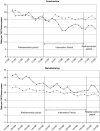Do drug-free workplace programs prevent occupational injuries? Evidence from Washington State
- PMID: 14965079
- PMCID: PMC1360996
- DOI: 10.1111/j.1475-6773.2004.00217.x
Do drug-free workplace programs prevent occupational injuries? Evidence from Washington State
Abstract
Objective: To evaluate the effect of a publicly sponsored drug-free workplace program on reducing the risk of occupational injuries.
Data sources: Workers' compensation claims data from the Washington State Department of Labor and Industries covering the period 1994 through 2000 and work-hours data reported by employers served as the data sources for the analysis.
Study design: We used a pre-post design with a nonequivalent comparison group to assess the impact of the intervention on injury risk, measured in terms of differences in injury incidence rates. Two hundred and sixty-one companies that enrolled in the drug-free workplace program during the latter half of 1996 were compared with approximately 20,500 nonintervention companies. We tested autoregressive, integrated moving-average (ARIMA) models to assess the robustness of our findings.
Principal findings: The drug-free workplace intervention was associated (p < .05) with a statistically significant decrease in injury rates for three industry groups: construction, manufacturing, and services. It was associated (p < .05) with a reduction in the incidence rate of more serious injuries involving four or more days of lost work time for two industry groups: construction and services. The ARIMA analysis supported
Conclusions: The drug-free workplace program we studied was associated with a selective, industry-specific preventive effect. The strongest evidence of an intervention effect was for the construction industry. Estimated net cost savings for this industry were positive though small in magnitude.
Figures
References
-
- Alleyne BC, Stuart P, Copes R. Alcohol and Other Drug Use in Occupational Facilities. Journal of Occupational Medicine. 1991;33(4):496–500. - PubMed
-
- Bureau of Labor Statistics . Washington, DC: U.S. Department of Labor; 2002. Workplace Injuries and Illnesses in 2000.
-
- Bush DM, Autry JH. Substance Abuse in the Workplace: Epidemiology, Effects, and Industry Response. Occupational Medicine: State of the Art Reviews. 2002;17:13–25. - PubMed
-
- Costantinou M. The Drug Testing Industry Is a Multibillion Dollar Profit Center. 2001. San Francisco Chronicle August 12.
-
- Elam E, Taylor V, Ciol MC, Franklin GM, Deyo RA. Impact of a Workers' Compensation Practice Guideline on Lumbar Spine Fusion in Washington State. Medical Care. 1997;35(5):417–24. - PubMed


